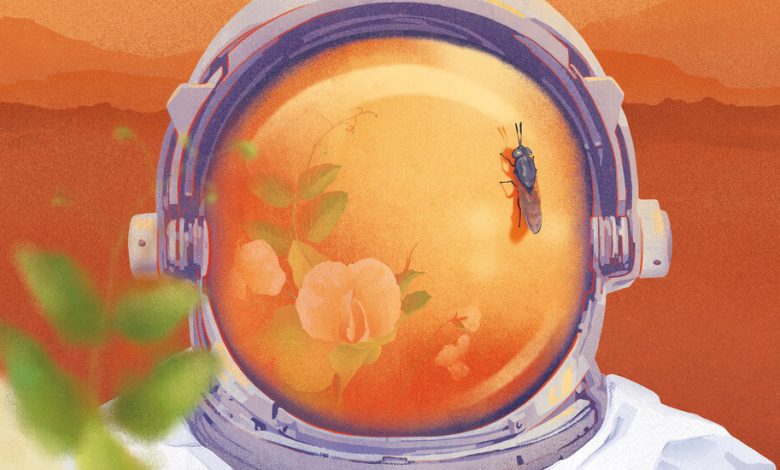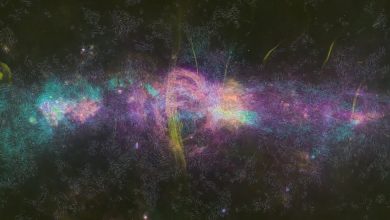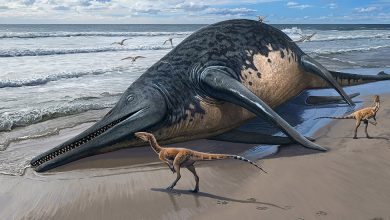Mars Needs Insects

At first it was just one flower, but Emmanuel Mendoza, an undergraduate student at Texas A&M University, had worked hard to help it bloom. When this five-petaled thing burst forth from his English pea plant collection in late October, and then more flowers and even pea pods followed, he could also see, a little better, the future it might foretell on another world millions of miles from Earth.
These weren’t just any pea plants. Some were grown in soil meant to mimic Mars’s inhospitable regolith, the mixture of grainy, eroded rocks and minerals that covers the planet’s surface. To that simulated regolith, Mr. Mendoza had added fertilizer called frass — the waste left after black soldier fly larvae are finished eating and digesting. Essentially, bug manure.
The goal for Mr. Mendoza and his collaborators was to investigate whether frass and the bugs that created it might someday help astronauts grow food and manage waste on Mars. Black soldier fly larvae could consume astronauts’ organic waste and process it into frass, which could be used as fertilizer to coax plants out of alien soil. Humans could eat the plants, and even food made from the larvae, producing more waste for the cycle to continue.
While that might not ultimately be the way astronauts grow food on Mars, they will have to grow food. “We can’t take everything with us,” said Lisa Carnell, director for NASA’S Biological and Physical Sciences Division.
But gardening doesn’t just require a plot of land, a bit of water, a beam of sunlight. It also requires very animate ingredients: the insects, like black soldier flies, and microorganisms that keep these ecological systems in working order. A trip to Mars for a long-term stay, then, won’t just involve humans. It will also involve creeping, crawling carry-ons most people don’t think about when they envision brave explorers stepping foot on new worlds.
🪰🌱🧑🚀
Space travelers haven’t yet gone very far for very long.
“Currently, when you’re going into space, it’s more like going on a prolonged camping trip,” said Scott Parazynski, a former NASA astronaut who spent nearly two months in space. Astronauts bring freeze-dried food (and flavor enhancers like hot sauce). If they’re on the International Space Station, they might get to look at, but rarely consume, fresh greens from an experimental lettuce plot.
“It’s a far cry from the kitchen downstairs and the spice rack,” Dr. Parazynski said.
To stay for an extended time on the surface of Mars, though, astronauts won’t be able to rely on their space pantries. They’ll need Martian gardens. And Martian gardens will need a little help — maybe from black soldier fly larvae and their excretions.
“They’re very voracious eaters,” said Hellen Elissen a researcher at Wageningen University and Research in the Netherlands. “They eat almost anything.” And if you feed them well, they’ll make a lot of frass.
In the past five or 10 years scientists have started to use that frass — rich in nitrogen, potassium, phosphorous and also bacteria — as fertilizer. The material also contains chitin, from the insects’ bodies, and leftover organic matter. Dr. Elissen recently published a review article about how frass affects plants and soil, and one of her main takeaways was that the value of the insects’ waste coincides with the value of their food. Grass? Frass suffers. Give the larvae higher-energy food scraps? Jackpot.
“You know what they say about you are what you eat?” she said. “The same goes for larvae.”
Jeffery Tomberlin, an entomology professor at Texas A&M University, knows this well after 25 years of studying black soldier flies. And he’s recruited others to his cause. A graduate student, Noah Lemke, for instance, arrived at Texas A&M to research black soldier flies’ reproductive behavior. Through the university’s Aggie Research Program, which lets graduate students recruit undergraduates for specific projects, he met Mr. Mendoza, an aerospace engineering major who had tried to grow radishes in simulated Martian soil in high school.

Credit…Adara Sánchez
“His project header was ‘Black soldier flies can feed the world, but we need more of them,’” Mr. Mendoza said. Mr. Mendoza thought maybe the flies could, instead, help feed another world.
“I thought, ‘Well, what’s to stop me from using this as a catalyst to develop my interest in space agriculture?’” he said.
Soon the idea for a whole system came together. The larvae could eat astronauts’ food waste and produce frass to fertilize bad alien soil, which could then produce food plants. Then the larvae themselves could be ground into a protein source, which astronauts — or animals they might bring along — could consume. “You have this system where humans are feeding the flies, the flies are feeding the plants and animals, the plants and animals are feeding the humans,” Mr. Mendoza said.
They decided to test frass’s fertilizing capabilities on English peas, planted in simulated Martian soil.
Dr. Tomberlin was initially skeptical.
“When they came to me and said, ‘Hey, we want to get Martian soil,’ I was like, ‘Where did you get Martian soil?’” he said. “They’re like, ‘Oh, no, we’ve got a supplier.’”
It was the Martian Garden, a company based in Texas.
Simulated regolith in hand, the trio mixed the frass with the simulated Martian soil in different proportions, to see how the peas liked it. In a pilot experiment, those combinations ranged from zero frass and all regolith to all frass and no regolith, covering percentages in between. The group then compared those plants’ growth to that of greenery ensconced in consumer plant soil, also fertilized with various frass proportions. After that trial, they shrank the range, trying frass percentages from zero to 50.
“The peas perform similarly in both Martian soil and potting mix,” Mr. Lemke said, at least if the conditions are right.
“Too much of the frass is bad for the plant health,” Mr. Lemke said. The plants receive too many nutrients. Too little frass, and they don’t receive enough nitrogen, which also isn’t conducive to sprouting. The optimal amount was “around 10 percent, and that seems to work well,” Mr. Lemke said. The microbes that frass mixes in also seem to help, as does crushing up the regolith — a mortar-pestle kind of task for future astronauts — so it can better absorb water.
Mr. Mendoza recently presented the trio’s results at the Entomological Society of America conference, and he hopes to use his engineering background to begin work on a physical system that could actually be used in space exploration, keeping the insects contained and productive far from their terrestrial home.
🪰🌱🧑🚀
Mr. Mendoza, Mr. Lemke and Dr. Tomberlin’s research pushes forward work that NASA and other space research groups have been doing for years, including studies on how the space environment affects bugs, microbes and other living things. “Tardigrades, nematodes, fruit flies, yeast fungus,” Dr. Carnell said. “We look at everything.”
On the food front, researchers have done a bit of combining flora and fauna. The Florida-based Interstellar Lab is a finalist in NASA’s Deep Space Food Challenge, working on a self-contained plant-and-mushroom-growing system that includes insects; here, the insects live separately from the plants but produce carbon dioxide for their consumption. “We are looking at how do we bring the right microbes that we can now create a soil mixture that is much more robust,” Dr. Carnell said.
A recent study from scientists at China Agricultural University, in the journal Communications Biology, showed that three kinds of intermingled bacteria, let loose in lunar soil simulant, helped plants grow bigger and greener by converting phosphorus trapped in the desolate soil into the sort that plants could consume.
But the presence of those microbes, she continued, leads to other questions, such as how those tiny tag-alongs might change in space or on the surface of another world, and how they will affect the human astronauts’ microbiomes.
On Earth, homebound researchers have used simulated Martian soil, as Mr. Mendoza did, to learn about crop growth on that otherworldly world.
A new set of research recommendations for NASA’s Biological and Physical Sciences Division has cleared space for more projects like these in the coming 10 years. Within those recommendations, the agency is considering a campaign called BLiSS: Bioregenerative Life Support Systems, with a goal of building and understanding “the systems that would provide high-quality food, refresh air and water, process wastes and enable the creation of space environments sustainable for long periods of time independent of Earth.”
The soldier-fly system, Dr. Carnell says, fits in well with that idea. “It consumes the waste; it can make fertilizer; it’s bringing so much benefit,” she said. Not to mention that astronauts could eat the insect larvae for a hearty dinner — or a post-microgravity-workout protein shake.
Eating peas fertilized by fly larvae is one thing, but eating the insect babies themselves may prove harder for astronauts to swallow. “As long as the nutrition is there, they’re probably to make it work somehow,” Dr. Parazynski said, “but I wouldn’t want to be the first one to grab that meal.”
Either way, humans will have to take — and live with — squirming companions, along with some that are too small to see, anywhere they would like to go beyond Earth — because the only way to survive out there is to make it more like down here, a planet that teems with nutrient-rich beasts.



